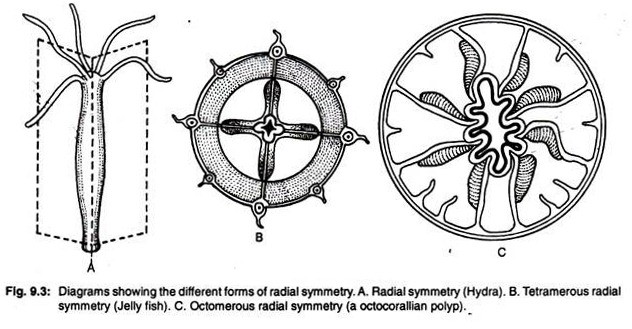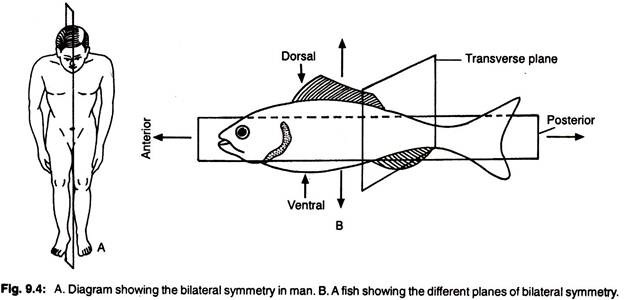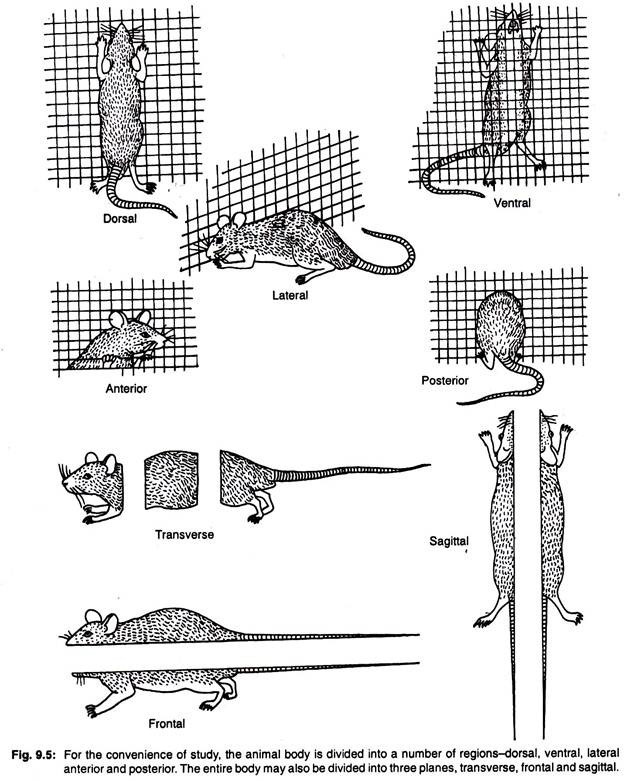Which Of The Following Correctly Describes The Major Types Of Animals
The following points highlight the five main types of symmetry seen in animals. The types are: 1. Asymmetrical Symmetry two. Spherical Symmetry iii. Radial Symmetry 4. Biradial Symmetry 5. Bilateral Symmetry.
Type # i. Asymmetrical Symmetry :
In some animals in that location are no body axis and no plane of symmetry, hence the animals are called asymmetrical. The amoeboid forms (due east.g., Amoeba) and many sponges accept irregular growth pattern of the body and cannon exist divided into two equal halves (Fig. 9.1).

Blazon # 2. Spherical Symmetry :
In spherical symmetry the shape of the body is spherical and lack any centrality. The body tin can exist divided into 2 identical halves in any plane that runs through the organism'southward centre. In asymmetrical symmetry and spherical symmetry the polarity does not exist and spherical symmetry is seen in radiolarian protozoa (Fig. 9.ii).

Type # iii. Radial Symmetry :
In radial symmetry the trunk tin be divided into two roughly equal halves past whatever i of many vertical planes passing through the primal axis (Fig. 9.3A-C) like the spokes of a wheel. The animals which showroom primarily radial symmetry are cylinder in grade and the similar parts of the body are arranged as around the axis. The centrality extends from the eye of the mouth to the centre of the aboral side.
The radial symmetry is seen among the sessile and sedentary animals such every bit in some sponges, hydroids, anthozoan polyps, medusae and ocean stars.
Special forms of radial symmetry are observed in different groups of animals such as:
(i) Tetramerous symmetry:
Many jelly fishes possess iv radial canals and the trunk can be divided into 4 equal parts. Hence the animals exhibit tetramerous raidal symmetry (Fig. nine.3B).
(two) Pentamerous symmetry:
Most echinoderms possess pentamerous radial symmeattempt because the body tin be divided into five roughly equal parts (Fig. xx.1). The body parts are arranged around the centrality of the rima oris at orientations of 72° apart. The larvae of echinoderms are bilaterally symmetrical but acquires radial symmetry in developed phase. The radial symmetry of echinoderms is regarded equally a secondary acquisition.
(iii) Hexamerous symmetry:
The sea anemones and true coral polyps vest to the subclass Hexacorallia (class Anthozoa). The mesenteries and tentacles are bundled in the multiple of six. The mesenteries are usually paired and are bundled in the multiple of six. The body of hexacorallian polyps exhibits hexameric plan and accept sixfold internal symmetry.
(iv) Octomerous symmetry:
The body of octocorallian polyps (bracket Octocorallia) shows octomeric radial symmetry and contains eight hollow marginal tentacles and 8 mesenteries and the trunk tin can be divided into 8 equal parts (Fig. 9.3C).

The animals with radial symmetry do not have anterior and posterior sides or dorsal and ventral surfaces. They have a oral cavity bearing oral side and the side abroad from the oral fissure called the aboral side.
Type # four. Biradial Symmetry :
The trunk of animals which exhibits biradial symmetry, represents a combination of both radial and bilateral symmetry. The organs are arranged radially and the torso can be divided into ii by a mid-longitudinal plane. Ctenophores exhibit biradial symmetry.
Type # 5. Bilateral Symmetry :
In bilateral symmetry the body parts are arranged in such a fashion that the animal is divisible into roughly mirror paradigm halves through one plane (mid sagittal airplane) but (Fig. 9.4A). This plane passes through the centrality of the body to carve up the two halves which are referred to as the right and left halves.
The animals which exhibit bilateral symmetry chosen bilateria. Bilaterally symmetrical animals include acoelomates, pseudo-coelomates and eucoelomates amidst invertebrates and both lower chordates and vertebrates.
The entire body of a bilateria can be divided into three planes such every bit— (i) frontal (2) sagittal and (iii) transverse (Fig. ix.4). Any of the vertical planes perpendicular to the sagittal plane that passes through the body separating the upper and underside is called frontal plane.
The upper-side is also called dorsal which is usually away from the ground and most the dorsum of the animal. The underside is likewise chosen ventral which is usually facing towards basis. A longitudinal plane that passes along the centrality of the body of bilaterally symmetrical animate being to separate correct and left sides is chosen the mid- sagittal airplane (Fig. 9.4B).

An imaginary aeroplane that crosses the body, perpendicular to the mid sagittal aeroplane called transverse plane. The torso of bilateria has the term lateral (two sides of the body), anterior (the end which usually moves forward during movement and bears mouth) and posterior (Fig. nine.five) (the finish opposite to anterior).

Advantages of Symmetry:
one. Bilateral symmetry is associated with the term cephalization—meaning the specialization of the anterior finish of the body to form the head where the nervous tissues, sense organs and feeding organs are concentrated.
2. Other advantages of this symmetry are the streamlining of the body, evolution of dissimilar organs in different body regions and more than efficient unidirectional move.
3. Radial symmetry helps the animals for collecting food and defense.
Source: https://www.biologydiscussion.com/animals-2/5-main-types-of-symmetry-seen-in-animals/32414
Posted by: pearsonprooroo.blogspot.com

0 Response to "Which Of The Following Correctly Describes The Major Types Of Animals"
Post a Comment